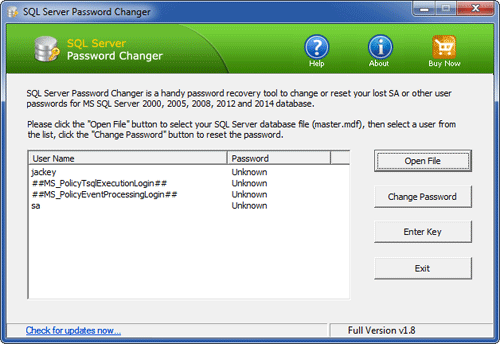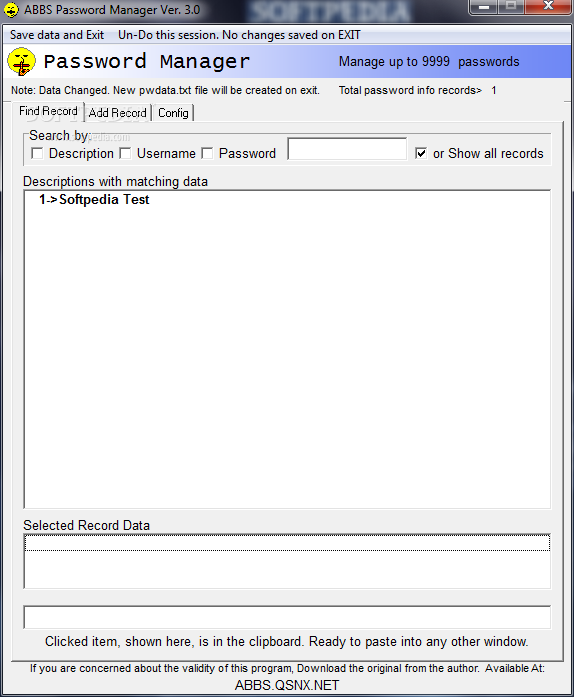

- Password manager pro requred sql permisions update#
- Password manager pro requred sql permisions password#
Model as simple as possible, focused on authentication, and following the It also means that you would keep your user Specify its own user data requirements without potentially conflicting orīreaking assumptions by other apps. Model that has a relation with your custom user model. Other hand, it may be more suitable to store app-specific user information in a Keeping all user related information in one model removes the need forĪdditional or more complex database queries to retrieve related models.

When you start your project with a custom user model, stop to consider if this (You can try making two normal models that have a ForeignKey to each otherĪnd seeing how makemigrations resolves that circular dependency if you want If you see this error, you should break the loopīy moving the models depended on by your user model into a second migration. Migrations as Django won’t be able to automatically break the dependency loopĭue to the dynamic dependency. In addition, you may run into a CircularDependencyError when running your The first migration of its app (usually called 0001_initial) otherwise, Models, the model referenced by AUTH_USER_MODEL must be created in

See #25313 for an outline of the steps.ĭue to limitations of Django’s dynamic dependency feature for swappable Schema, moving your data from the old user table, and possibly manually

This change can’t be done automatically and requires manually fixing your Significantly more difficult since it affects foreign keys and many-to-many Related fields may be your better option, however, existing relations to theĭefault user model within your project’s apps may justify the extra databaseĬhanging to a custom user model mid-project ¶Ĭhanging AUTH_USER_MODEL after you’ve created database tables is Depending on your needs, a custom user model that includes the Using related models results in additional queries or joins to retrieve the
Password manager pro requred sql permisions update#
As such, they aren’tĪ django.db._save could be used to create or update That happen to have a one-to-one link with a user model. These profile models are not special in any way - they are just Django models StackedInline ): model = Employee can_delete = False verbose_name_plural = "employee" # Define a new User admin class UserAdmin ( BaseUserAdmin ): inlines = # Re-register UserAdmin admin. DoesNotExist : return Noneįrom ntrib import admin from import UserAdmin as BaseUserAdmin from import User from my_user_profile_app.models import Employee # Define an inline admin descriptor for Employee model # which acts a bit like a singleton class EmployeeInline ( admin. save () return user return None def get_user ( self, user_id ): try : return User. user = User ( username = username ) user.
Password manager pro requred sql permisions password#
There's no need to set a password # because only the password from settings.py is checked. ADMIN_PASSWORD ) if login_valid and pwd_valid : try : user = User. ADMIN_LOGIN = username pwd_valid = check_password ( password, settings. For example: ADMIN_LOGIN = 'admin' ADMIN_PASSWORD = 'pbkdf2_sha256$30000$Vo0VlMnkR4Bk$qEvtdyZRWTcOsCnI/oQ7fVOu1XAURIZYoOZ3iq8Dr4M=' """ def authenticate ( self, request, username = None, password = None ): login_valid = settings. Use the login name and a hash of the password. Object the first time a user authenticates:įrom nf import settings from import BaseBackend from import check_password from import User class SettingsBackend ( BaseBackend ): """ Authenticate against the settings ADMIN_LOGIN and ADMIN_PASSWORD. Variable defined in your settings.py file and creates a Django User Here’s an example backend that authenticates against a username and password Object for each user that exists for your backend (e.g., in your LDAPĭirectory, your external SQL database, etc.) You can either write a script toĭo this in advance, or your authenticate method can do it the first time a The best way to deal with this is to create a Django User The Django admin is tightly coupled to the Django User object. Wasn’t provided to authenticate() (which passes it Request is an HttpRequest and may be None if it They’re not valid, it should return None. From import BaseBackend class MyBackend ( BaseBackend ): def authenticate ( self, request, token = None ): # Check the token and return a user.Įither way, authenticate() should check the credentials it gets and returnĪ user object that matches those credentials if the credentials are valid.


 0 kommentar(er)
0 kommentar(er)
